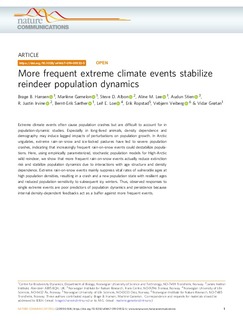More frequent extreme climate events stabilize reindeer population dynamics
Hansen, Brage B.; Gamelon, Marlène; Albon, Steve D.; Lee, Aline M.; Stien, Audun; Irvine, R. Justine; Sæther, Bernt-Erik; Loe, Leif E.; Ropstad, Erik; Veiberg, Vebjørn; Grøtan, Vidar
Journal article

Åpne
Permanent lenke
http://hdl.handle.net/11250/2596999Utgivelsesdato
2019Metadata
Vis full innførselSamlinger
- Scientific publications [1392]
Originalversjon
10.1038/s41467-019-09332-5Sammendrag
treme climate events often cause population crashes but are difficult to account for in
population-dynamic studies. Especially in long-lived animals, density dependence and
demography may induce lagged impacts of perturbations on population growth. In Arctic
ungulates, extreme rain-on-snow and ice-locked pastures have led to severe population
crashes, indicating that increasingly frequent rain-on-snow events could destabilize populations.
Here, using empirically parameterized, stochastic population models for High-Arctic
wild reindeer, we show that more frequent rain-on-snow events actually reduce extinction
risk and stabilize population dynamics due to interactions with age structure and density
dependence. Extreme rain-on-snow events mainly suppress vital rates of vulnerable ages at
high population densities, resulting in a crash and a new population state with resilient ages
and reduced population sensitivity to subsequent icy winters. Thus, observed responses to
single extreme events are poor predictors of population dynamics and persistence because
internal density-dependent feedbacks act as a buffer against more frequent events.
